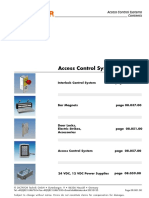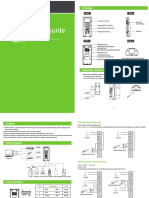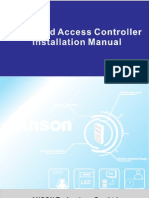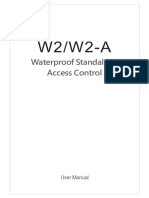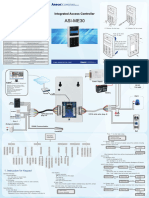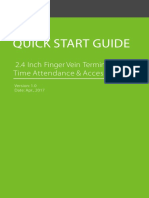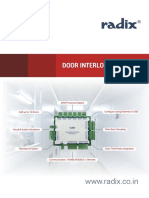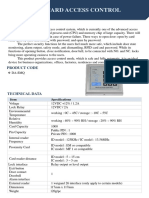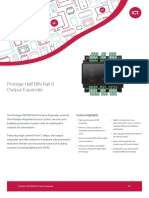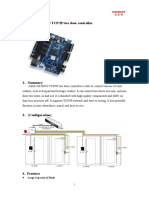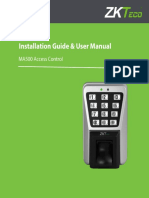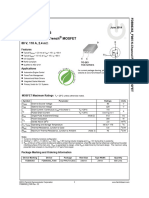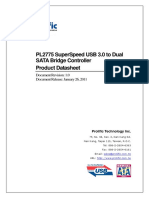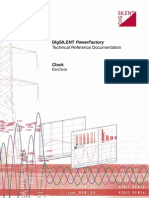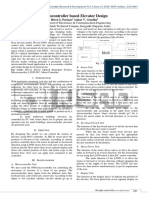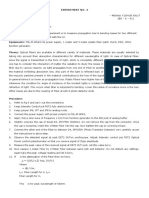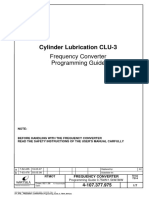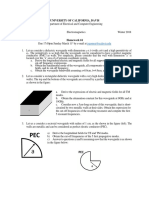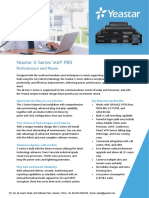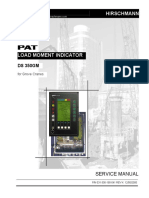Interlock Control System Complete
Uploaded by
sheezankhanInterlock Control System Complete
Uploaded by
sheezankhanInterlock Control System
Interlock Control System
For the Access Control to e.g. Clean Rooms or
Laboratories
In clean rooms, laboratories, hospitals
etc. doors may often be opened only
when others are closed. The DICTATOR
interlock control system facilitates an easy
configuration of these relations, without a
complex PLC control system. The relations
are "programmed" directly by DIP switches.
Trained persons not requiring any special
programming know-how can modify
them on site at any time.
For an easy mounting the components of
the newest generation are connected as
telephones or networks by cables with
RJ45 connectors (exception: ex-proof
version). The power pack for the 24 VDC
supply is provided with a safety plug.
The interlock doors can be unlocked either
by pushing the corresponding key on the
terminals or free of contact by a transpon-
der, the transponder system having an
integrated access control.
There are two exceptions from the plug-in
version(here the complete electrical wiring
has to be effected by the customer):
- the ex-proof version,
- the SP interlock control system for flush
fitted switch boxes or pattresses.
System Versions Peripheral system Extremely flexible, modular structure, can be extended at any
beginning on page time, complex special functions possible, also for installations
08.011.00 with doors far apart.
Central system For small systems with max. 5 doors (optionally 8 doors). Max.
08.019.00 et sqq. cable length 15 m. Depth of terminals only about 27 mm.
Ex-proof version For max. 5 doors (optionally 8 doors). Central controller for
beginning on page mounting outside hazardous area, optionally with ex-proof
08.027.00 casing. Also not ex-proof doors can be integrated.
Switch box version The components of the terminals are mounted in an off-the-
SP beginning on shelf switch system. Used with central controller, electric con-
page 08.037.00 nection to be provided by the customer.
© DICTATOR Technik GmbH • Gutenbergstr. 9 • 86356 Neusäß • Germany
Tel. +49(0)821-24673-0 • Fax +49(0)821-24673-90 • E-mail info@dictator.de • 1046 Page 08.003.00
Interlock Control System
DICTATOR Interlock Control System -
General Information
In the DICTATOR interlock control system all doors of the interlock control system are
generally locked and are released only temporarily when the operating key of the
terminal is pressed. This offers the highest possible safety within the interlock system.
Every door is controled by a separate control board. With the peripheral system these
are integrated in the control terminal of the respective door, with the central system the
control boards of all doors forming part of the system are united in a central controller.
The ex-proof interlock control system is a modified version of the central system.
Unlocking the Doors - The peripheral system as well as the central one of the DICTATOR interlock control
systems offer two basic options to unlock the doors:
Options
- Terminals with key
(The peripheral system and the one with central controller RJ use the piezo-type
key with illuminated ring described in the following. Information on the keys in the
ex-proof system and those for the SP switch box system can be found on the pages
08.031.00 and 08.040.00.)
- RFID terminals without key operated by transponder (integrated access control)
Terminals with piezo-type key Terminals with integrated
for unlocking by access control by
pressing transponder
Another possibility to unlock the door is to connect an extern switch, e.g. a large surface
switch.
Piezo-type key The piezo-type key is ideally suited for its use in clean rooms. It features no mechanical
moving parts where dirt could settle and it is not subject to mechanical wear. It offers
a very long operational life of 20 million operations. It also is very resistant to environ-
mental influences. Its operation requires only a very slight pressure.
Indication of the door status
The illumination on the terminals clearly signals the user whether the respective door can
be used or is locked at the moment (indication of the door status). The terminals
of the peripheral and the central system have an illuminated ring around the operating
key. The ex-proof terminals have an extra illuminated green/red indicator:
Green: The door is locked but can be opened by pushing the operating key.
Red: The door is locked. It cannot be opened as it is locked by another open door.
The illumination of the ring will return to green as soon as the other door is
closed again.
© DICTATOR Technik GmbH • Gutenbergstr. 9 • 86356 Neusäß • Germany
Page 08.004.00 Tel. +49(0)821-24673-0 • Fax +49(0)821-24673-90 • E-mail info@dictator.de • 1046
Interlock Control System
DICTATOR Interlock Control System -
General Information, cont.
The terminals with piezo-type key and transponder of the peripheral and central interlock
control system can be combined at will, also on one door. Both models have the same
dimensions.
This allows, if necessary, to equip certain areas of the interlock system with an auto-
matic access control without needing additional devices.
Transponder Often certain areas of the interlock system shall be accessible only to a limited group
of people. Usually this is controlled by additional access control systems.
DICTATOR now has developed terminals for the interlock system that feature an inte-
grated access control. The piezo-type key is replaced by a RFID system. This allows
to change authorizations any time and also to attribute different authorizations within
one interlock system.
On both sides of each door different authorizations can be programmed.
Instead of pushing the piezo-type key, the door is unlocked by a transponder. The RFID
system has been designed so that it can be operated by off-the-shelf tranponder chips.
The maximum reading distance between terminal and transponder chip is approx. 3 cm.
Transponder chip requirements
- Frequency: 125 kHz
- Storage: 64 Bit
- Type of chip: EM 4100, EM 4102, EM 4200
e.g. DICTATOR transponder chip WD1
(see also page 08.069.00), part no. 710878
Programming
The receivers in the terminals are programmed by a master chip and a delete chip.
These should have a different colour than the normal transponder chips.
To train the transponder chips you firstly hold a delete chip close to the receiver, then
the master chip and after this the transponder chips to be trained. With the master chip
you can delete the access authorization of individual tranponder chips any time.
To administer the issued authorizations you use a PC with a RFID reading device to read
the transponder chip identifications.
In case transponder chips which meet the a.m. requirements are already being used
in the building, these can directly be read. Then there is no need of extra transponder
chips in the interlock control system.
Indication of the door status
The terminals of the transponder series signal the actual status of the door and the re-
ception standby by three different luminous diodes. The function of the green and red
LED corresponds to the illuminated ring of the piezo-type keys.
Green: The door is locked but can be opened by transponder.
Red: The door is locked. It cannot be opened as it is locked by another open door.
The illumination of the ring will return to green as soon as the other door is
closed again.
Blue: The blue LED informs about the recognition of the transponder chips.
© DICTATOR Technik GmbH • Gutenbergstr. 9 • 86356 Neusäß • Germany
Tel. +49(0)821-24673-0 • Fax +49(0)821-24673-90 • E-mail info@dictator.de • 1046 Page 08.005.00
Interlock Control System
DICTATOR Interlock Control System -
General Information, cont.
The interlock control system is a very flexible system. Without needing a time-consuming
new programmation, the complete interlock control system can easily be adapted to
changing requirements.
"Programming" One of the main features of the
DICTATOR interlock control system is the
very easy "programming" of the
relations between the doors. No computing
skills at all are needed.
All relations are adjusted by DIP switches.
The peripheral version features these DIP
switches directly in the control terminals.
In the central system they are placed on
the circuit boards in the central controller.
The relations between the doors can be
adapted any time. It is also easily possible
to later enlarge the interlock control system.
More detailed information and a
programming example can be found on
page 08.009.00.
On the same circuit board (either in the
control terminal or in the central controller)
you can adjust by a potentiometer the time
during which the door will remain unlocked,
i.e. the door can be opened after the
operating key has been pressed. It is of
no importance whether the door is really
opened or not. The period to be adjusted
depends on whether it is an interlock for
people or material.
Emergency-Open Switch The door terminals of the peripheral and the central interlock control system are available
either with just an operating key or with an additional emergency-open switch.
In case of an emergency the door can be unlocked by means of the emergency-open
switch even while being locked by the interlock control system. The switch remains
locked after having been pressed. In order to reactivate the interlock control system the
emergency-open switch has to be unlocked by turning. After a short delay the system
is ready to work again.
If necessary, the emergency-open switch can be protected by an extra cover against
unauthorised use (cover prepared for a lead seal, see page 08.045.00).
Two different emergency-open functions are possible:
- Local emergency-open (LNA): unlocks only the door of the respective terminal.
- Global emergency-open (GNA): unlocks all doors of the group.
© DICTATOR Technik GmbH • Gutenbergstr. 9 • 86356 Neusäß • Germany
Page 08.006.00 Tel. +49(0)821-24673-0 • Fax +49(0)821-24673-90 • E-mail info@dictator.de • 1046
Interlock Control System
DICTATOR Interlock Control System -
General Information, cont.
The DICTATOR interlock control system is a modular system which can also integrate
non-system components. Depending on the chosen version it also offers a great variety
of additional possibilities.
Some of the options mentioned in the following are not possible in the ex-proof version
of the system or the system for switch range SP. Details about these two versions and the
possible options can be found beginning on page 08.027.00 or 08.037.00.
Locking Devices To lock interlock doors bar magnets, electric strikes etc. can be used. A big choice can
be found in the catalogue beginning on page 08.047.00.
But already installed locking devices can also be included in the DICTATOR interlock
control system. For this purpose they have to meet the following requirements:
- they dispose of a feedback contact which is closed when the door is closed (if
necessary, it can be mounted separately),
- they function with 24 VDC and
- they are locked with current (requirement of the EltVTR).
Access Controls Access controls can be connected to all terminals of the interlock control system (only
exception are the ex-proof ones). There are two options for their functioning:
- entering the access code automatically releases the door.
- in addition to entering the access code the piezo-type key of the terminal has to be
pressed.
A choice of access control systems can be found beginning on page 08.067.00.
Acces control systems that are already installed have to have a potential-free make
contact (NO) (switching time about 1 sec.).
If possible, the access control system should function with 24 VDC as it then can be fed
by the power pack of the interlock control system.
Additional Switches (e.g. The DICTATOR interlock control system allows also to connect large surface switches
or something similar to adapt the interlock control system optimally to the needs of the
Large Surface Switches) users. Large surface switches are very convenient when the persons passing through
the interlock door have to carry something and therefore don't have empty hands or
when they are handicapped.
Integration of Emergency Interlock control systems often also include emergency exits. These have to be equipped
according to the requirements of the EltVTR (German standard for electrical locking
Exits systems on emergency exits).
For this purpose DICTATOR has developed as a special component the emergency exit
terminal which has been tested and approved by the TÜV Thüringen. This terminal can
easily be integrated in a DICTATOR interlock control system.
Especially in clean rooms interlock control systems form part of a production process.
Door Operators
There doors often should open automatically. The DICTATOR interlock control system
also easily allows to integrate door operators in the interlock system. The door operator
should have the following characteristics:
- automatic closing or a separate control device for a closing command.
- signal output "door closed" (NO). (If not available, a separate feedback contact has
to be mounted.)
Depending on the type of the DICTATOR interlock control system there are different
Time Control possibilities to reopen certain doors of the interlock system only after an adjustable
period. This can be achieved either directly by some terminals or by an additional time
control unit.
© DICTATOR Technik GmbH • Gutenbergstr. 9 • 86356 Neusäß • Germany
Tel. +49(0)821-24673-0 • Fax +49(0)821-24673-90 • E-mail info@dictator.de • 1046 Page 08.007.00
Interlock Control System
DICTATOR Interlock Control System -
General Information, cont.
The DICTATOR interlock control system is an extremely flexible system. Depending on the
type (peripheral, central, ex-proof) it can be combined to different extents with facility
management systems and a large number of additional functions can be achieved.
The standard version of the DICTATOR interlock control system (peripheral or central) is
very easy to mount and connect. No specialist is needed. All intrasystem components
are connected by flat cables with RJ45 connectors. Also the power pack is ready for
plug-in in a 230 VAC socket.
Discretion Circuit The interlock control system allows to establish a discretion/delaying circuit for any
doors. These doors cannot be opened from the outside even when all other doors
are closed, as long as they are locked from the inside by a separate switch (e.g. for
undisturbed changing).
Relay Controlled The control terminals of the peripheral system and the control boards of the central system
dispose of different signal outputs/status indications.
Additional Functions They all can be used for transmission to a facility management system.
The peripheral interlock control system allows also for many relay based additional
functions. Among these are:
- Starting a ventilation/heating.
- Switching on/off lighting.
- Controling a pressure compensation.
- Optical/acoustic warning signals.
Number of Doors in The DICTATOR interlock control system has been designed for smaller interlock systems.
Due to its very easy mounting, wiring and "programming" the DICTATOR interlock control
Interlock Systems system represents an ideal solution to the always increasing requirements regarding
hygiene and clean rooms.
The number of doors in the interlock control system depends on the type of the interlock
control system.
Peripheral interlock control system
The standard version of the peripheral system has been designed for up to 8 doors. But
it also can be used for more doors if the doors can be combined to several groups. At
a maximum there can be controlled 8 groups of doors with 8 doors each.
Central interlock control system
The version with the central controller has been designed for installations with up to
5 doors. But also the central system is flexible and can be extended to up to 8 doors.
But this system requires that all connected doors have to be within the reach of a 15 m
cable to the central controller.
Ex-proof interlock control system
The ex-proof system is based on the central control system and therefore also can con-
trol only up to 5 doors. Same as the central interlock control system this system can be
extended to a maximum of 8 doors. But here the ex-requirements have to be observed.
SP interlock control system for flush fitted switch boxes or pattresses
The interlock control system for the switch system LS 990 uses the central controller
of the ex-proof version which has to be wired on site. The maximum number of doors
corresponds to the one of the central system.
Just ask us. We will work out a free of charge offer with a solution proposal.
© DICTATOR Technik GmbH • Gutenbergstr. 9 • 86356 Neusäß • Germany
Page 08.008.00 Tel. +49(0)821-24673-0 • Fax +49(0)821-24673-90 • E-mail info@dictator.de • 1046
Interlock Control System
Interlock Control System - Programming
The following matrix helps you to determine the position of the DIP switches on the control
boards. Just mark for each door which other door(s) may be open at the same time and
which one(s) must stay locked (see example below).
There are 3 positions for the DIP switches:
Position +: defines the door for which the relations are set (basis door)
Position -: this door is locked as long as the "basis door" is open.
Position 0: this door can be opened even though the "basis door" is open, too.
Clean room Required relations
interlock system (determined by the customer)
with 5 doors Clean room Door open Door locked
Door 1 Door 2
Door 2 Doors 1, 3 and 4
Door 3 Door 3 Doors 2 and 4
Door 4 Doors 2, 3 and 5
Door 5 Door 4
Door 5 Door 4
Interlock 3 Interlock 2 Interlock 1
Door 2 Door 1
Matrix for setting the
positions of the DIP switches
Door number Admissible state of the other doors of the interlock system
depending on the open "basis door"
No. of the
basis door 1 2 3 4 5 6 7 8
1 + - 0 0 0 0 0 0
2 - + - - 0 0 0 0
3 0 - + - 0 0 0 0
4 0 - - + - 0 0 0
5 0 0 0 - + 0 0 0
6
7
© DICTATOR Technik GmbH • Gutenbergstr. 9 • 86356 Neusäß • Germany
Tel. +49(0)821-24673-0 • Fax +49(0)821-24673-90 • E-mail info@dictator.de • 1046 Page 08.009.00
Interlock Control System
DICTATOR Interlock Control System - Summary
On the following pages you will find detailed information about the different types
of the DICTATOR interlock control system and the components which can be used for
upgrading the peripheral as well as the central version.
Peripheral interlock control system
Overview page 08.011.00
Components page 08.012.00
Control terminals ST3 page 08.013.00
Operating terminals BT3 page 08.014.00
Distribution box page 08.015.00
Connection cables page 08.017.00
Order information page 08.018.00
Central interlock control system
Overview page 08.019.00
Components page 08.020.00
Central controller RJ page 08.021.00
Operating terminals BTZ page 08.023.00
Operating terminals BT3 page 08.024.00
Connection cables page 08.025.00
Order information page 08.026.00
Ex-proof interlock control system
Overview page 08.027.00
Components page 08.028.00
SK central controller page 08.029.00
Operating terminals BTZ EX page 08.031.00
Ex-proof locking magnet page 08.032.00
Order information page 08.036.00
SP interlock control system for flush fitted switch
boxes or pattresses
Overview page 08.037.00
Components page 08.038.00
SK central controller page 08.039.00
Operating terminals for switch range page 08.040.00
Order information page 08.041.00
Additional components for the peripheral and
the central type
Emergency exit terminal page 08.043.00
Time control unit page 08.044.00
Mounting accessories page 08.045.00
Order information page 08.046.00
© DICTATOR Technik GmbH • Gutenbergstr. 9 • 86356 Neusäß • Germany
Page 08.010.00
08.0010.00 Tel. +49(0)821-24673-0 • Fax +49(0)821-24673-90 • E-mail info@dictator.de • 1046
Interlock Control System
Peripheral System
Peripheral Interlock Control System -
Overview
The peripheral DICTATOR interlock control system is the most flexible type of the inter-
lock control systems. Its modular structure offers the possibility to meet an extraordinary
number of special requirements.
All intrasystem components are connected by pluggable cables. Except for the alimen-
tation these are flat cables with RJ45 connectors.
The peripheral interlock control system has been designed for up to 8 doors respectively
groups of doors of maximum 8 doors each.
Basic Set-up The basic set-up of the peripheral DICTATOR interlock control system is very simple:
The doors of the interlock system are directly controlled by the control terminals on the
doors. The distribution boxes work as junctions between the control terminals. Depen-
ding on the number of doors in the interlock system and their spatial arrangement, 1 to
max. 4 doors can be connected to a distribution box (see also page 08.015.00). The
distribution boxes are connected by pluggable cables, one for the power supply and
one as control cable.
The distribution box is connected to each of its respective doors by a pluggable control
cable and power cable.
Every door needs a control terminal. In case the door shall be controlled from both
sides, an operating terminal has to be mounted on the other side of the door. As this is
controled by the control terminal, it does not need an elaborate circuit board.
The locking element of the door (bar magnet, electric strike etc.) is connected directly
to the control terminal.
All control cables, also the one to the locking element, are simple flat cables with RJ45
connectors. If necessary, it is possible to lengthen them by a connector to a maximum
length of 15 m.
The system also offers the possibility to integrate the interlock control system in a facility
management system, to realise special functions, to output status information etc.
Power
supply
(ready for Distribution Distribution Distribution
red = SL
plug-in) box 1 box 2 box 3
black = SV
FH FH FH
blue = VV blue = VV blue = VV
BT3 ST3 BT3 ST3 BT3 ST3
yellow = VL yellow = VL yellow = VL
Door 1* Door 2* Door 3*
Rear Front Rear Front Rear Front
*: To each distribution box can be Legend: SL = control cable (red)
connected 1 to maximum 4 doors ST3 = control terminal SV = power cable (black)
(4 doors only when in total only BT3 = operating terminal VL = connection cable ST3-BT3 (yellow)
1 distribution box is used, see page FH = bar magnet/locking device VV = connection cable ST3-FH (blue)
08.015.00)
© DICTATOR Technik GmbH • Gutenbergstr. 9 • 86356 Neusäß • Germany
Tel. +49(0)821-24673-0 • Fax +49(0)821-24673-90 • E-mail info@dictator.de • 1046 Page 08.011.00
Interlock Control System
Peripheral System
Peripheral Interlock Control System -
Components
The peripheral DICTATOR interlock control system consists of a few main components.
They are completed by mounting accessories and components for special functions.
The locking elements used have to meet two requirements: A feedback contact that is
closed when the door is closed, and to function with 24 VDC quiescent current, i.e.
with current they are locked (requirement of the EltVTR = German standard for electrical
locking systems on emergency exits).
System Components Control terminal
Per door there is needed one control terminal. It is the core of the peripheral interlock
control system. In the control terminal are determined the relations of this door in reference
to the other doors of the interlock system by DIP switches. It can be provided either with
a simple operating key or with an additional emergency-open switch.
There are available three versions of the control terminal: Basic, Plus (for additional
functions) and as RFID terminal for transponder chip. Further details can be found on
the next pages.
Operating terminal
Normally an additional terminal is required for the rear side of the door. This operating
terminal comprises corresponding to the used control terminal either only an operating
key or the RFID system or also the emergency-open switch. The operating terminal is
connected to the control terminal by a flat cable with RJ45 connector.
Connection cable
The connection cables play an essential part in making the DICTATOR interlock control
system such an easy to handle system. All control cables and the connection to the locking
elements are flat cables with RJ45 connectors. The cables and the corresponding sockets
are clearly marked by colours to prevent any faulty connection during installation. In
case of need, the cables can easily be lengthened by using simple connectors up to a
maximum distance of 15 m between the components.
For the power supply there are available, depending on the required function, 2 core
or 6 core cables with connectors on both ends.
Distribution box
The distribution box has been designed for 1 to maximum 4 doors. Both, the control
cable and the power cable, are simply clipped to it. In addition it offers space tor the
relays needed for additional functions.
Central power pack
The 24 VDC power supply of the terminals and the locking units is provided by a central
power pack. It is available either with 2.7 A or 5 A power. The power pack is furnished
ready for mounting with a mains cable with safety plug and a 2 m long 24 VDC cable
with 6-pin connector to one of the distribution boxes of the system, i.e. it doesn't have
to be opened for connection.
Locking elements
For locking the doors there is available a large choice of bar magnets and electric strikes
(see page 08.047.00 and the following). It is essential that the used locking devices
dispose of a potential-free feedback contact.
Emergency exit terminal for emergency exit doors according to EltVTR
In case of emergency exits in the interlock system, it is easy to integrate them with the
help of the tested emergency exit terminal.
Time control unit
If the interlock system includes doors that shall be free only after a certain time (for de-
contamination, reaching determined temperatures etc.) and the remaining time should
be indicated to the persons in the interlock, the DICTATOR time control unit together with
the corresponding secondary indication displays will accomplish this.
© DICTATOR Technik GmbH • Gutenbergstr. 9 • 86356 Neusäß • Germany
Page 08.012.00 Tel. +49(0)821-24673-0 • Fax +49(0)821-24673-90 • E-mail info@dictator.de • 1046
Interlock Control System
Peripheral System
Peripheral Interlock Control System -
Control Terminal
The control terminal is the central component of the peripheral DICTATOR interlock
control system as it contains the control circuit board where the relations between
the different doors are set. It is available as a Basic and a Plus version and as RFID
terminal for transponder chip, all versions with or without the emergency-open switch.
The DICTATOR terminals meet the requirements of clean rooms. As operating button a
piezo-type key is used that reacts on very little pressure. Both front plate and key are
made of stainless steel.
The front plates of the terminals have been designed for their mounting in hollow profi-
les. On demand, front plates with differing measurements and with the customer's logo
are available.
Dimensions
Control terminal ST3 Required installation Control terminal ST3oN
with emergency-open depth: 42 mm with operating key,
and operating key without emergency-open
part no. 710910 (Basic) part no. 710912 (Basic)
part no. 710900 (Plus) part no. 710902 (Plus)
with RFID system for transponder with RFID system for transponder
part no. 710980 part no. 710982
Performance Basic version (with piezo-type key or RFID system)
- 1 signal output for actuating the emergency-open switch (if included)
- 1 signal output (to be configured by a jumper)
Plus version (only with piezo-type key)
- 1 signal output for actuating the emergency-open switch (if included)
- 2 signal outputs (to be configured by jumpers)
- Integrated time control unit without display (adjustable times: 1, 2, 3, 4, 5 minutes.
Different times are possible on demand.)
Technical Data Power consumption with emergency-open 24 VDC +/-15 %, max. 50 mA
without emergency-open 24 VDC +/-15 %, max. 40 mA
IP rating IP 20* (operating key/emergency-open: IP 65)
Capacity per output 250 mA, make contact (NO)
Operating temperature -10 °C to +40 °C
piezo-type key with red/green circle illumina-
Operation tion (requires only a pressure of 1,5 - 3 N!)
or transponder in case of RFID system
*IP rating when not built in.
Emergency-open switch mushroom-type push-to-lock, illuminated
The final IP rating depends
on the mounting situation. Emergency-open contact set (capacity) 1 make contact (NO): 500 mA
Material front plate stainless steel 1.4301
© DICTATOR Technik GmbH • Gutenbergstr. 9 • 86356 Neusäß • Germany
Tel. +49(0)821-24673-0 • Fax +49(0)821-24673-90 • E-mail info@dictator.de • 1046 Page 08.013.00
Interlock Control System
Peripheral System
Peripheral Interlock Control System -
Operating Terminal
Normally the doors of an interlock system are used from both sides. Therefore, an additional
operating terminal (without control board), connected to the control terminal, is required
on the rear side of the door. The operating terminal is available only as standard type.
The front plates of the terminals have been designed for their mounting in hollow profi-
les. On demand, front plates with differing measurements and with the customer's logo
are available.
Dimensions
Operating terminal BT3 Operating terminal BT3oN
with emergency-open and with operating key,
operating key without emergency-open
part no. 710901 part no. 710903
with RFID system for transponder with RFID system for transponder
part no. 710981 part no. 710983
The operating terminal is connected to the control terminal by the connection cable with
RJ45 connector (marked yellow). The cable has to be ordered separately. By default
two lengths are available:
- 250 mm (part no. 710936)
- 1000 mm (part no. 710937).
To the operating terminal, same as the control terminal, can directly be connected an
access control (already integrated in the operating terminal with RFID system) or also a
large surface switch for example.
Technical Data Power consumption 24 VDC +/-15 %
with emergency-open max. 30 mA
without emergency-open max. 15 mA
IP rating IP 20* (operating key/emergency-open: IP 65)
Operating temperature -10 °C bis +40 °C
piezo-type key with red/green circle illuminati-
Operation
on or transponder in case of RFID system
*IP rating when not built in. The
Emergency-open switch mushroom-type push-to-lock, illuminated
final IP rating depends on the
mounting situation. Emergency-open contact set (capacity) 1 make contact (NO): 500 mA
Material front plate stainless steel 1.4301
© DICTATOR Technik GmbH • Gutenbergstr. 9 • 86356 Neusäß • Germany
Page 08.014.00 Tel. +49(0)821-24673-0 • Fax +49(0)821-24673-90 • E-mail info@dictator.de • 1046
Interlock Control System
Peripheral System
Peripheral Interlock Control System -
Distribution Box
The simple wiring of all the components in the peripheral interlock control system is
based on the distribution box(es). If there are several distribution boxes, these are con-
nected with a pluggable control cable and power cable each. The control terminals of
the corresponding doors are then connected to the distribution box by also pluggable
connection cables.
Number of Required Each distribution box disposes of 4 sockets each for the control and the power cables.
These are used to connect the control terminals and, if needed, several distribution boxes.
Distribution Boxes
Example 1:
Interlock system with 4 adjoining
doors Distribution Power
box VK pack
Here one distribution box is sufficient to
connect all doors directly.
Example 2:
Socket for Interlock system with 8 doors
power supply To the distribution box 1 can be con-
nected 3 doors. The 4th sockets are
needed for the connection cables to the
2nd distribution box.
X5X5 To the 2nd distribution box can be
Door 4 Door 3 Door 2 Door 1
connected 2 doors as 1 socket each is
needed for the incoming and one each for the outgoing cables. To the 3rd distribution
box there can again be connected 3 doors as only one socket each is needed for the
incoming connection cables.
Socket for control cable
(RJ45 connector)
Distribution boxes VK
VK3 VK2 VK1
Power pack
Door 8 Door 7 Door 6 Door 5 Door 4 Door 3 Door 2 Door 1
Function If required, the function global emergency-open (when pressing one emergency-
Global Emergency-Open open switch, all doors are unlocked) is adjusted in the distribution box. To achieve this,
there is fitted an additional relay (part no. 710921) with pluggable connection cable
X6 Relay
Relais in only one distribution box of the interlock control system. It is simply clipped to the
standard top hat rail in the distribution box. For the connector of this connection cable
the additional socket X6 is reserved.
ATTENTION: When choosing the global emergency-open, the 6 core power cable has
to be used!
© DICTATOR Technik GmbH • Gutenbergstr. 9 • 86356 Neusäß • Germany
Tel. +49(0)821-24673-0 • Fax +49(0)821-24673-90 • E-mail info@dictator.de • 1046 Page 08.015.00
Interlock Control System
Peripheral System
Peripheral Interlock Control System -
Distribution Box, cont.
Generally the distribution boxes are fixed in the suspended ceiling or the conductor rail
above the corresponding doors. But they can also be mounted at a central place if the
distance to the control terminals is not longer than 15 m.
Additional Adjustable The X5 terminal strip can be used for special functions. For example, to additionally
lock any doors by a "privacy switch" (changing rooms) and to connect an external time
Functions control unit with display.
The delivery of the distribution box includes a connector for the X5 terminal strip which
facilitates an easy connection of these devices.
Dimensions
Distribution box
part no. 710922
The strain relief of the incoming and outgoing cables is achieved by fixing the cables
with tie wraps to the two cable support brackets. The cable inlets are sealed dust proof
by cellular material.
For fixing 4 borings of Ø 5.4 mmn are provided in the casing of the distribution boxes.
Technical Data Material hot-dip galvanised sheet steel
IP rating IP 20
Top hat rail type TS35/7.5 according to EN 60715
© DICTATOR Technik GmbH • Gutenbergstr. 9 • 86356 Neusäß • Germany
Page 08.016.00 Tel. +49(0)821-24673-0 • Fax +49(0)821-24673-90 • E-mail info@dictator.de • 1046
Interlock Control System
Peripheral System
Peripheral Interlock Control System -
Connection Cables
All components of the peripheral interlock control system are mainly connected by
simple flat cables with colour marked RJ45 connectors. Only for the power supply are
used 2 or 6 core cables with corresponding connectors, depending on the required
additional functions.
This significantly reduces the mounting costs and the danger of errors when connecting
the single components.
Connection Cables Connection cable control - operating terminal (1)
The connection cable between control and operating terminal is a flat cable with yellow
marked RJ45 connectors on both ends. It is available with 250 mm and 1 m length. In
case the door is equipped with both, a control and an operating terminal, it always has
to be ordered additionnally.
But when only a control terminal is mounted on a door there just has to be put a jumper
(J1) in the corresponding place on the circuit board.
Control cable (2)
The control cable is used to connect all the distribution boxes as well as to connect the
control terminals to their corresponding distribution box. The control cable is also a flat
cable with RJ45 connectors. The control cable connectors and the corresponding plug-in
positions are marked red.
Standard lengths: 3 m, 5 m and 10 m
By means of a connector (part no. 710943) several cables can be linked up to the
maximum total length of 15 m between two components.
Connection of door locking device or door operator (3)
As the DICTATOR interlock control system can be combined with a multitude of locking
devices the connection cable for the locking device or door operator is furnished only
on one end with a RJ45 connector (blue colour). This is plugged in the control terminal.
On the other end of the cable are 4 free leads which are marked explicitly (2 leads for
the feedback contact and 2 leads for the power supply).
Standard lengths: 250 mm, 2 m, 4 m and 15 m.
black (4) VK
Power cable (4)
NT red (2) FH The cable for the power supply is available with 2 or 6 cores. It is used to connect the
different distribution boxes as well as to connect the control terminals to the correspon-
ding distribution box.
blue (3)
ST3 The 6 core cable has always to be used when a global emergency-open is required, a
BT3
control terminal of the Plus version is used or special functions shall be realised.
The power cables are provided on both ends with connectors which are simply plugged
yellow (1)
in the distribution box and the control terminal. For the 2 core cables are used just the
plug-in positions that are marked - and +.
Standard lengths: 3 m, 5 m, 10 m and 15 m
Door
Rear Front
Connection of external components
Additional components as access controls or large surface switches have to be connected
to the interlock control system by the customer. The control terminal disposes for their
connection of a pluggable 3-pin screw terminal.
© DICTATOR Technik GmbH • Gutenbergstr. 9 • 86356 Neusäß • Germany
Tel. +49(0)821-24673-0 • Fax +49(0)821-24673-90 • E-mail info@dictator.de • 1046 Page 08.017.00
Interlock Control System
Peripheral System
Peripheral Interlock Control System -
Order Information
On this page you will find a summary of the part numbers of all components of the
peripheral DICTATOR interlock control system.
Other accessories:
- Boxes for flush and surface mounting of the terminals page 08.045.00
- Emergency exit terminal page 08.043.00
- Time control unit page 08.044.00
- Power packs page 08.071.00 et sqq.
- Locking devices page 08.047.00 et sqq.
Order Information Control terminal ST3 Basic part no. 710910
Terminals Control terminal ST3oN Basis, without emergency-open switch part no. 710912
(see page 08.013.00 and following) Control terminal ST3 Plus part no. 710900
Control terminal ST3oN Plus, without emergency-open switch part no. 710902
Control terminal ST3T RFID system part no. 710980
Control terminal ST3ToN RFID system, without emergency-open part no. 710982
Operating terminal BT3 part no. 710901
Operating terminal BT3oN, without emergency-open switch part no. 710903
Operating terminal BT3T RFID system part no. 710981
Operating terminal BT3ToN RFID system, without emergency-open part no. 710983
Transponder chip WD1 (see also page 08.069.00) part no. 710878
Distribution Box Distribution box VK3 part no. 710922
(see page 08.015.00 and following) Additional relay for global emergency-open, pluggable part no. 710921
Kit of 4 pluggable 6 core screw terminals for VK3 part no. 710923
Time Control Unit Time control unit ZS part no. 710805
(see page 08.044.00) Additional display ZA for time control unit part no. 710806
Extender circuit module for additional displays part no. 710808
Connection Cables Connection cable control - operating terminal, yellow 250 mm part no. 710936
(see page 08.017.00) Connection cable control - operating terminal, yellow 1m part no. 710937
Control cable with RJ45 connector on both ends, red 3m part no. 710940
Control cable with RJ45 connector on both ends, red 5m part no. 710941
Control cable with RJ45 connector on both ends, red 10 m part no. 710942
Connection cable locking device/door operator, blue 250 mm part no. 710939
Connection cable locking device/door operator, blue 2m part no. 710938
Connection cable locking device/door operator, blue 4m part no. 710928
Connection cable locking device/door operator, blue 15 m part no. 710946
Power cable with connector, 2 cores 3m part no. 710930
Power cable with connector, 2 cores 5m part no. 710931
Power cable with connector, 2 cores 10 m part no. 710932
Power cable with connector, 2 cores 15 m part no. 710929
Power cable with connector, 6 cores 3m part no. 710933
Power cable with connector, 6 cores 5m part no. 710934
Power cable with connector, 6 cores 10 m part no. 710935
Power cable with connector, 6 cores 15 m part no. 710944
Connector for flat cable with RJ45 connector part no. 710943
© DICTATOR Technik GmbH • Gutenbergstr. 9 • 86356 Neusäß • Germany
Page 08.018.00 Tel. +49(0)821-24673-0 • Fax +49(0)821-24673-90 • E-mail info@dictator.de • 1046
Interlock Control System
Central System
Interlock Control System with Central Controller -
Overview
The interlock control system with central controller RJ has especially been designed for
installations with up to 5 doors. It can be extended to 8 doors. The central interlock control
system is the ideal solution for small systems where all doors are located close to each
other. The maximum cable length between terminal and central controller RJ is 15 m.
The control circuit boards being placed in the control terminals in the peripheral system,
here are located in the central controller. The basic version of the central controller RJ
provides control boards for 2 doors. If the interlock system consists of more doors, the
controller RJ will be supplied with the corresponding number of control boards.
Basic Set-up In the central interlock control system RJ all terminals and locking devices on the doors
are directly connected to the central controller RJ.
On both sides of the doors are mounted operating terminals without controlling function.
The operating terminal BTZ which is connected to the central controller RJ only has two
RJ45 sockets:
Green: control cable from the central controller RJ.
Yellow: connection cable to second operating terminal (BT3) on the rear side of the door.
The second operating terminal is identic to the one of the peripheral system.
The locking device is also directly connected to the central controller RJ. The blue marked
cable is plugged in the central controller RJ in the designated RJ45 socket. The other end
of the cable has 4 leads of different colours to connect the locking device.
The power is provided by the power pack ready for plug-in. Its safety plug simply has
to be plugged in a socket provided on site. In the central controller RJ also a socket for
the power cable of the power pack is provided.
All control cables, also the cable to the locking device, are simple flat cables with RJ45
connectors. An additional power cable to the operating terminals as with the peripheral
system is not required.
Power pack (NT) Central controller RJ
(ready for plug-in) (ZS)
FH
g
BTZ BT3
Door 1
Front Rear
NT
Legend:
BTZ = operating terminal with green = connection cable ZS - BTZ
2 RJ45 sockets black = power cable NT - ZS
BT3 = operating terminal yellow = connection cable BTZ - BT3
FH = bar magnet/locking device blue = connection cable ZS - FH
© DICTATOR Technik GmbH • Gutenbergstr. 9 • 86356 Neusäß • Germany
Tel. +49(0)821-24673-0 • Fax +49(0)821-24673-90 • E-mail info@dictator.de • 1046 Page 08.019.00
Interlock Control System
Central System
Central Interlock Control System -
Components
The DICTATOR interlock control system with central controller consists of a few main
components. They can be mounted and "programmed" with extremely little effort.
Beside the basic functions many additional requirements can be met by the central
controller RJ of the DICTATOR interlock control system. For some standard components
can be used, for others an additional LAN module has to be used.
Mounting accessories can be found on page 08.045.00 and the following.
System Components Central controller RJ
Each installation requires one central controller RJ. Usually this can control up to 5 doors.
But it is possible to enlarge the system. The following options are available:
- Connection of a second central controller RJ. This allows to enlarge the system to up
to 8 doors (4 doors per central controller RJ).
- Connection of a distribution box of the peripheral interlock system (see page 08.015.00).
This allows to control 8 doors in total: 5 doors by the central controller RJ and 3 more
doors by the distribution box of the peripheral system. Each of these 3 doors needs
a control terminal of the peripheral system and if necessary, an operating terminal
BT3 - see page 08.013.00 and following.
- Direct connection of a control terminal of the peripheral system (see page 08.013.00),
i.e. there is added 1 door to the system to make it 6 doors in total.
Operating terminal BTZ
On every door an operating terminal BTZ has to be mounted. It is available either with
operating key or with RFID system for transponder chip.
The operating terminal BTZ provides 2 sockets for RJ45 connectors:
- green socket: connection cable to the central controller RJ,
- yellow socket: connection cable to an operating terminal BT3 on the rear side of the
door.
Operating terminal BT3
The operating terminal BT3 is also used for the peripheral interlock control system. It
completes the operating terminal BTZ on the rear side of the door. The only difference
is that the terminal BT3 has only one (yellow) socket.
It is available either with operating key or with RFID system for transponder chip.
Connection cables
All doors are easily connected to the central controller RJ by flat cables with RJ45
connectors. The cables and their corresponding sockets are clearly marked by different
colours (green, yellow, blue).
Central power pack
The 24 VDC power supply of the terminals and the locking devices is provided by a
central power pack. It is available either with 2.7 A or 5 A power. The power pack
is furnished ready for mounting with a mains cable with safety plug and a 2 m long
24 VDC cable with 6-pin connector to the central controller RJ of the installation, i.e. it
doesn't have to be opened for connection.
Locking devices
For locking the doors is available a large choice of bar magnets and electric strikes
(see page 08.047.00 and the following). It is essential that the used locking devices
dispose of a potential-free feedback contact.
Additional components
- Emergency exit terminal according to EltVTR (see page 08.043.00)
- Time control unit (see page 08.044.00)
© DICTATOR Technik GmbH • Gutenbergstr. 9 • 86356 Neusäß • Germany
Page 08.020.00 Tel. +49(0)821-24673-0 • Fax +49(0)821-24673-90 • E-mail info@dictator.de • 1046
Interlock Control System
Central System
Central Interlock Control System -
Central Controller RJ
The central controller RJ is the core of the central interlock control system. All control
boards are placed in the central controller RJ contrary to the peripheral system where
they are located in the respective control terminals. The standard version provides 2
control boards for 2 doors. In case the interlock control system consists of more doors,
the central controller RJ will contain the necessary number of control boards.
The main advantage of the central interlock control system is it requires even less con-
nection cables to the doors and all relations can be adjusted in the central controller RJ.
Structure The central interlock control system
has been designed for systems with
up to 5 doors. If necessary, it can
be used for up to 8 doors.
The central controller RJ consists of
a basic circuit board on which are
plugged the control boards of the
different doors. Above each control
board are 2 sockets:
- green socket for green connection
cable to the operating terminal BTZ
on the door.
- blue socket for the connection cable
to the locking device of this door.
The power cable of the power pack
is plugged in the 2-pin socket down
in the right corner.
Beside the basic functions several additional options can be achieved. The most important
Options ones are listed below, with the necessary accessories.
- Global emergency-open GNA
In case all doors of the interlock system should open once the emergency-open switch
on one of the operating terminals has been pressed (global emergency-open), this can
easily be achieved - also later - by adding a relay (part no. 710953) to the central
controller RJ. This relay is simply plugged in the provided socket.
- LAN module
It is possible to transmit status information and errors from the central controller RJ to a
facility mangement system. For this purpose the central controller RJ can be upgraded in
production with an additional circuit board (part no. 710954). This allows the facility
management system e.g. to trigger an alarm, to pass an information to the ventilation
system etc.
The LAN module is not included in the standard version!
- Achieving special functions as e.g. the discretion circuit
For this purpose an 8-pin screw-type terminal is provided in the central controller RJ.
- Time-delayed opening
In case it should be possible to reopen some doors only with a time delay, this can be
adjusted by a jumper on the respective control board.
- Integration of door operators
It is also possible to integrate door operators on (some) doors of the interlock system.
In this case the terminals on the respective doors have to be without emergency-open
and for the operator a separate emergency-open switch has to be mounted.
© DICTATOR Technik GmbH • Gutenbergstr. 9 • 86356 Neusäß • Germany
Tel. +49(0)821-24673-0 • Fax +49(0)821-24673-90 • E-mail info@dictator.de • 1046 Page 08.021.00
Interlock Control System
Central System
Central Interlock Control System -
Central Controller RJ - continuation
For systems with up to 8 doors the central controller RJ can be upgraded in several ways:
- Connection of another central controller RJ: max. 8 doors.
- Connection of a distribution box of the peripheral system. This also allows to control
8 doors in total.
- Direct connection of a control terminal of the peripheral system. This enlarges the
system by 1 door to a total of 6 doors.
Dimensions
The strain relief of the incoming and outgoing cables is achieved by fixing the cables
with tie wraps to the two cable support brackets. The cable inlets are sealed dust proof
by cellular material.
For fixing 4 borings of Ø 5.4 mm are provided in the casing of the central controller RJ.
Technical Data Voltage 24 VDC +/-15 %
Power consumption basic version 2 doors 100 mA
Power consumption per additional door 50 mA
Power consumption relay for global emergency-open 30 mA
Power consumption LAN module 100 mA
IP rating IP 20
Operating temperature -10 °C up to +40 °C
Material casing hot-dip galvanized sheet steel
Max. cable length to terminals/locking devices 15 m
© DICTATOR Technik GmbH • Gutenbergstr. 9 • 86356 Neusäß • Germany
Page 08.022.00 Tel. +49(0)821-24673-0 • Fax +49(0)821-24673-90 • E-mail info@dictator.de • 1046
Interlock Control System
Central System
Central Interlock Control System -
Operating Terminal BTZ
For the DICTATOR central interlock control system only simple operating terminals are
mounted on the doors.
The operating terminal BTZ is connected by a flat cable with RJ45 connectors (green)
directly to the central controller RJ. Usually on the rear side of the door an operating
terminal BT3 (also used for the peripheral system) is connected to the operating terminal
BTZ. The only difference between the two terminals is, that the BTZ has two sockets for
flat cable (one for the cable from the central controller RJ and one for the cable to the
operating terminal BT3).
Dimensions
39
25,2 2
n4
,5
87
130
119
°
x90
n8
25
1,2
28
Operating terminal BTZ Operating terminal BTZoN
with emergency-open with operating key,
and operating key without emergency-open
part no. 710904 part no. 710905
with RFID system for transponder with RFID system for transponder
part no. 710984 part no. 710985
The DICTATOR terminals meet the requirements of clean rooms. The operating terminal
BTZ is available with and without emergency-open switch.
For unlocking the operating terminal it is furnished either with a piezo-type key (stainless
steel) or with the RFID system for transponder.
The operating terminal BTZ can directly be connected to an access control (integrated
in the terminal with RFID system) or a large surface switch, for example.
The flat cable (green) for the connection to the central controller RJ is available in 4
different lengths: 3, 5, 10, 15 m (for part numbers see page 08.026.00).
Technical Data Power consumption 24 VDC +/-15 %
with emergency-open max. 30 mA
without emergency-open max. 15 mA
IP rating IP 20* (operating key/emergency-open: IP 65)
Operating temperature -10 °C to +40 °C
Operation piezo-type key with red/green circle illumination
or transponder in case of RFID system
*IP rating when not built in. The Emergency-open switch mushroom-type push-to-lock, illuminated
final IP rating depends on the
Emergency-open contact set (capacity) 1 make contact (NO): 500 mA
mounting situation.
Material front plate AISI 304
© DICTATOR Technik GmbH • Gutenbergstr. 9 • 86356 Neusäß • Germany
Tel. +49(0)821-24673-0 • Fax +49(0)821-24673-90 • E-mail info@dictator.de • 1046 Page 08.023.00
Interlock Control System
Central System
Central Interlock Control System -
Operating Terminal BT3
Normally the doors of an interlock system are used from both sides. Therefore, the
additional operating terminal BT3, connected to the operating terminal BTZ, is required
on the other side of the door.
The operating terminal BT3 is available with and without emergency-open switch.
The front plates of all terminals have been designed for their mounting in hollow profiles.
On demand, there are available front plates with differing measurements and with the
customer's logo.
Dimensions
Operating terminal BT3 Operating terminal BT3oN
with emergency-open with operating key,
and operating key without emergency-open
part no. 710901 part no. 710903
with RFID system for transponder with RFID system for transponder
part no. 710982 part no. 710983
The operating terminal BT3 is connected to the operating terminal BTZ by the connection
cable with RJ45 connector (marked yellow). The cable has to be ordered separately. By
default two lengths are available:
- 250 mm (part no. 710936)
- 1000 mm (part no. 710937).
The operating terminal BT3 can directly be connected to an access control (integrated
in the terminal with RFID system) or e.g. a large surface switch.
Technical Data Power consumption 24 VDC +/-15 %
with emergency-open max. 30 mA
without emergency-open max. 15 mA
IP rating IP 20* (operating key/emergency-open: IP 65)
Operating temperature -10 °C to +40 °C
Operation piezo-type key with red/green circle illumination
or transponder in case of RFID system
*IP rating when not built in. The
final IP rating depends on the Emergency-open switch mushroom-type push-to-lock, illuminated
mounting situation. Emergency-open contact set (capacity) 1 make contact (NO): 500 mA
Material front plate AISI 304
© DICTATOR Technik GmbH • Gutenbergstr. 9 • 86356 Neusäß • Germany
Page 08.024.00 Tel. +49(0)821-24673-0 • Fax +49(0)821-24673-90 • E-mail info@dictator.de • 1046
Interlock Control System
Central System
Central Interlock Control System -
Connection Cables
The components of the central interlock control system are connected by simple flat
cables with colour marked RJ45 connectors.
This significantly reduces the mounting costs and the danger of errors when connecting
the single components.
Connection Cables Connection cable central controller RJ - operating terminal BTZ (1)
The connection cable between central controller RJ and the operating terminals BTZ on
the respective doors is a flat cable with RJ45 connectors on both ends. The connectors
as well as the corresponding sockets are marked green.
Standard lengths: 3 m, 5 m , 10 m and 15 m
Connection cable operating terminals BTZ - BT3 (2)
The connection cable between the operating terminals BTZ and BT3 is also a flat cable
with RJ45 connectors on both ends. The connectors as well as the corresponding sockets
are marked yellow.
Available lengths: 250 mm and 1 m
Connection cable for door locking device or door operator (3)
As the DICTATOR interlock control system can be combined with a multitude of locking
devices the connection cable for the locking device or door operator is furnished only on
one end with a RJ45 connector (blue colour). This is plugged in the central controller RJ.
On the other end of the cable are 4 free leads which are marked explicitly (2 leads for
the feedback contact and 2 leads for the power supply).
Standard lengths: 250 mm, 2 m, 4 m and 15 m
Power cable (4)
The standard version of the central interlock control system does not require power cables
to the door terminals. The power pack is provided with a 2 m long, pluggable power
cable which has just to be plugged in the corresponding socket of the central controller.
Connecting a second central controller RJ
Power pack Central controller RJ
If a central system is upgraded by a second central controller RJ, two cables are needed
black (4) blue (3) to connect the two central controllers RJ:
FH - control cable red
- 6 core power cable
Details about these two types of cables are to be found on page 08.017.00.
BTZ BT3 Connecting a distribution box VK3 of the peripheral system
g
For controlling 8 doors also two cables are needed to connect the distribution box:
yellow (1) - control cable red
- 6 core power cable
Details about these two types of cables are to be found on page 08.017.00.
Door Connecting external components
Front Rear
NT
Additional components as access controls or large surface switches have to be connected
to the interlock control system by the customer. The operating terminals BTZ and BT3
dispose for their connection of a pluggable 3-pin screw terminal.
© DICTATOR Technik GmbH • Gutenbergstr. 9 • 86356 Neusäß • Germany
Tel. +49(0)821-24673-0 • Fax +49(0)821-24673-90 • E-mail info@dictator.de • 1046 Page 08.025.00
Interlock Control System
Central System
Central Interlock Control System -
Order Information
On this page you will find a summary of the part numbers of all components of the
DICTATOR central interlock control system.
Other accessories:
- Flush and surface mounting boxes for the terminals page 08.045.00
- Emergency exit terminal page 08.043.00
- Time control unit page 08.044.00
- Power packs page 08.071.00 et sqq.
- Locking devices page 08.047.00 et sqq.
Order Information Operating terminal BTZ part no. 710904
Terminals Operating terminal BTZoN, without emergency-open switch part no. 710905
(see page 08.023.00 and following)
Operating terminal BTZT RFID system for transponder part no. 710984
Operating terminal BTZToN RFID system, without emergency- part no. 710985
open switch
Operating terminal BT3 part no. 710901
Operating terminal BT3oN, without emergency-open switch part no. 710903
Operating terminal BT3T RFID system for transponder part no. 710982
Operating terminal BT3ToN RFID system, without emergency- part no. 710983
open switch
Transponder chip WD1 (see also page 08.069.00) part no. 710878
Central Controller RJ Central controller RJ basic version for 2 doors part no. 710920
(see page 08.021.00 and following)
Central controller RJ for 3 doors part no. 710920-3
Central controller RJ for 4 doors part no. 710920-4
Central controller RJ for 5 doors part no. 710920-5
Additional relay for global emergency-open, part no. 710953
retrofittable, for central controller
Additional circuit board (LAN module) for part no. 710954
connection to facility management system,
to be retrofitted in production
Connection Cables Connection cable operating terminals BTZ - BT3, 250 mm part no. 710936
(see page 08.025.00) yellow
Connection cable operating terminals BTZ -BT3, 1m part no. 710937
yellow
Connection cable central controller RJ - BTZ, green 3m part no. 710947
Connection cable central controller RJ - BTZ, green 5m part no. 710948
Connection cable central controller RJ - BTZ, green 10 m part no. 710949
Connection cable central controller RJ - BTZ, green 15 m part no. 710952
Connection cable locking/door operator, blue 250 mm part no. 710939
Connection cable locking/door operator, blue 2m part no. 710938
Connection cable locking/door operator, blue 4m part no. 710928
Connection cable locking/door operator, blue 15 m part no. 710946
Connector for flat cable with RJ45 connector part no. 710943
© DICTATOR Technik GmbH • Gutenbergstr. 9 • 86356 Neusäß • Germany
Page 08.026.00 Tel. +49(0)821-24673-0 • Fax +49(0)821-24673-90 • E-mail info@dictator.de • 1046
Interlock Control System
Ex-Proof System
Ex-Proof Interlock Control System -
Overview
The interlock control system for hazardous areas functions similar to the system with
central controller. The control boards of all doors belonging to the interlock system are
united in a casing. Whenever it is possible the central controller should be mounted
outside the hazardous area. However, it also can be placed, together with the power
pack, in an ex-proof casing and then be mounted within the hazardous area.
The ex-proof interlock control system allows to control a maximum of 5 doors in the
hazardous area. But it is possible to extend the ex-proof interlock control system to up
to 8 doors.
Basic Set-up In the ex-proof interlock control system all feeding lines from the terminals and locking
devices of the doors are directly led to the EX central controller and connected there. In
hazardous areas flat cables and RJ45 connectors cannot be used.
On the doors is mounted the ex-proof operating terminal BTZ EX. Contrary to most ex-
proof operating devices it is as small and aesthetically attractive as the terminals of the
other DICTATOR interlock control system types. There are available two versions of the
terminal BTZ EX. It always has an operating key to request the opening of the door and
a LED light to indicate the status of the door. The light is either green or red, same as
the illuminated ring of the door terminals of the other interlock control systems. On both
sides of the door the same type of terminal is mounted. Both are directly connected to
the EX central controller. In addition the operating terminal can also be equipped with
an emergency-open switch.
As locking device is used an ex-proof DICTATOR electromagnet with separate feedback
contact. Magnet and feedback contact are also directly connected to the SK central
controller of the ex-proof interlock control system.
The power pack which is ready for plug-in supplies the power. Its safety plug is plugged
in a socket on site. In the SK central controller is provided a socket for the power cable
of the power pack.
Power pack (NT) Central controller SAFE AREA
(ready for plug-in) SK
HAZARDOUS AREA EM GD EX
g
BTZ EX BTZ EX
Door 1
Front Rear
Legend:
NT
BTZ EX = ex-proof operating terminal
EM GD EX = ex-proof electromagnet
© DICTATOR Technik GmbH • Gutenbergstr. 9 • 86356 Neusäß • Germany
Tel. +49(0)821-24673-0 • Fax +49(0)821-24673-90 • E-mail info@dictator.de • 20171115 Page 08.027.00
Interlock Control System
Ex-Proof System
Ex-Proof Interlock Control System -
Components
The ex-proof DICTATOR interlock control system consists of a few main components.
Its structure is very simple. The system is also characterised by the extremely simple
programming and the attractive, small terminals.
The standard version of the SK central controller and the corresponding power pack
are intended for their mounting outside the hazardous area. In case that is not possible,
both components can be mounted in an ex-proof casing.
System Components SK Central controller
There is needed one SK central controller per system. The controller itself is not ex-proof
(see above). Usually it can control up to 5 doors. But it is possible to enlarge the system.
The following options exist:
- Connection of a second SK central controller. This allows to control 8 doors in the
hazardous area.
- Connection of a distribution box of the peripheral interlock control system (see page
08.015.00). This allows to control in total 8 doors: 5 doors from the SK central con-
troller and from the distribution box of the peripheral system 3 more doors which need
a control terminal of the peripheral system and if necessary an operating terminal BT3
- see page 08.013.00 et sq.). These 3 doors, however, have to be located outside
the hazardous area.
- Direct connection of a control terminal of the peripheral system (see page 08.013.00).
This adds 1 door to a total of 6 doors. But also with this version the additional door
has to be located outside the hazardous area.
To the SK central controller also doors outside the hazardous area can be connected (see
information on peripheral and central interlock control system). But as the cables have
to be connected in the SK central controller and cannot be plugged in there is needed
an adaptor for the connection of flat cables with RJ45 connector.
Operating terminal BTZ EX
On every door in the hazardous area an operating terminal BTZ EX has to be fitted.
The operating terminal is provided with the corresponding connection cables to the EX
central controller.
Central power pack
The 24 VDC power supply of the SK central controller is provided by a power pack. It
is available either with a power of 2.7 A or 5 A. The power pack is furnished ready for
mounting with a mains cable with safety plug and a 2 m long 24 VDC cable with 6-pin
connector to the SK central controller, i.e. it doesn't have to be opened for connection.
The power pack is not ex-proof.
Door locking device
In the hazardous area an ex-proof electromagnet is used to lock the doors. Information
about the magnet can be found beginning on page 08.032.00. In addition there is
required a separate ex-proof feedback contact on the doors.
Time-delayed opening
In the SK central controller it can be adjusted that certain doors of the interlock system are
released only after a delay. The remaining time, however, is not indicated in the interlock.
Information about more components for doors outside the hazardous area can be found
on the pages about the peripheral resp. central interlock control system.
© DICTATOR Technik GmbH • Gutenbergstr. 9 • 86356 Neusäß • Germany
Page 08.028.00 Tel. +49(0)821-24673-0 • Fax +49(0)821-24673-90 • E-mail info@dictator.de • 20171115
Interlock Control System
Ex-Proof System
Ex-Proof Interlock Control System -
SK Central Controller
In the ex-proof interlock control system all electrically relevant parts are combined in
the SK central controller. The operating terminals are connected by screw terminals as
hazardous areas require special cables and the flat cables of the not ex-proof version
cannot be used. Apart from that the SK central controller corresponds mostly to the
central controller RJ.
The standard version contains 2 control boards for 2 doors. In case the interlock system
consists of more doors, the SK central controller will be provided with the corresponding
number of control boards.
Structure The SK central controller has been
designed for systems with a maximum
of 5 doors. But in case of need, with
a second SK central controller you
can control in total 8 doors in a
hazardous area.
The SK central controller contains
a basic circuit board on which is
attached a control board for every
door. Above each control board are
3 terminal strips:
- KL 1 to connect the ex-proof electro-
magnet and the separate feedback
contact,
- KL 6 to connect the luminous diode
of the terminal,
- KL 11 to connect the Emergency-
Open switch (of the operating terminal or a separate emergency-open switch)
The connection cable from the power pack is plugged in the 2 pin socket down in the
right corner.
Options Beside the basic functions a number of additional options are possible. Below are listed
the most important ones with the necessary accessories.
- LAN module
It is possible to transmit status information and errors from the SK central controller
to a facility mangement system. For this purpose the SK central controller can be up-
graded in production with an additional circuit board (part no. 710954). This allows
e.g. the facility management system to trigger an alarm, to pass an information to the
ventilation system etc.
The LAN module is not included in the standard version!
- Achieving special functions as e.g. the discretion circuit
For this purpose an 8-pin screw-type terminal is provided in the SK central controller.
- Time-delayed opening
In case it should be possible to reopen some doors only with a time delay, this can be
adjusted by a jumper on the respective control boards.
- Integration of door operators
It is also possible to integrate door operators on (some) doors of the interlock system.
In this case the terminals on the respective doors have to be without emergency-open
and a separate emergency-open switch has to be mounted for the operator (e.g. ex-
proof push-to-lock switch, part no. 700254, page 04.067.00).
© DICTATOR Technik GmbH • Gutenbergstr. 9 • 86356 Neusäß • Germany
Tel. +49(0)821-24673-0 • Fax +49(0)821-24673-90 • E-mail info@dictator.de • 20171115 Page 08.029.00
Interlock Control System
Ex-Proof System
Ex-Proof Interlock Control System -
SK Central Controller - continuation
For systems with up to 8 doors the SK central controller can be upgraded in several ways:
- Connection of another SK central controller: max. 8 doors in hazardous area.
- Connection of a central controller RJ: up to 8 doors in total, max. 5 doors in hazardous
area, rest outside hazardous area.
- Connection of a distribution box of the peripheral system: up to 8 doors in total, max.
5 doors in hazardous area.
- Direct connection of a control terminal of the peripheral system. This way the system
can be enlarged by 1 door to a total of 6 doors, max. 5 doors in hazardous area.
Components of the peripheral system can be connected by using the adaptor with the
part number 710964.
Dimensions
The strain relief of the incoming and outgoing cables is achieved by fixing the cables
with tie wraps to the two cable support brackets. The cable inlets are sealed dust proof
by cellular material.
To fix the SK central controller 4 borings of Ø 5.4 mm are provided in the casing.
If the SK central controller has to be mounted within the hazardous area,
it is fitted together with the power pack into an ex-proof casing of the
ex-protection type Ex II 2G Ex de IIC T6. The dimensions and the exact model depend
on the number of doors the ex-proof interlock control system consists of.
Technical Data Voltage 24 VDC +/-15 %
Power consumption basic version 2 doors 100 mA
Power consumption per additional door 50 mA
Power consumption LAN module 100 mA
IP rating IP 20
Operating temperature -10 °C to +40 °C
Material casing hot-dip galvanized sheet steel
Max. cable length to terminals/locking devices 15 m
Fuse for connected EX magnets (per circuit board) 5x20 medium time lag, 200 mA
Ex-protection type of optional EX casing Ex II 2G Ex de IIC T6
© DICTATOR Technik GmbH • Gutenbergstr. 9 • 86356 Neusäß • Germany
Page 08.030.00 Tel. +49(0)821-24673-0 • Fax +49(0)821-24673-90 • E-mail info@dictator.de • 20171115
Interlock Control System
Ex-Proof System
Ex-Proof Interlock Control System -
Operating Terminal BTZ EX
A special feature of the ex-proof interlock control system are the operating terminals on
the doors. They are as small, unobtrusive, elegant and suitable for clean rooms as the
terminals of the "normal" DICTATOR interlock control systems.
With the ex-proof terminals a separate luminous display indicates the status of the door.
Depending on the status it shows a green or red light.
The terminals are furnished with cables for their connection to the SK central controller.
When ordering the terminals please consider the required length of cable (5, 10 or 15 m).
Dimensions 4,3
n
42,5 48
12
2
39,5
39
n4
,3
106,3
165
154
70,5
130
n8x
90°
Connection of
equipotential bonding
39
conductor
Connection of
n8
x9 n22
0°
20,5 equipotential bonding
Cable length
conductor
depending on execution
Cable length 5, 10, 15 m
depending on execution
5, 10, 15 m
Operating terminal BTZoN EX Operating terminal BTZ EX
with operating key, with emergency-open and
without emergency-open operating key
part no. 710950 part no. 710955 (LNA)
The operating terminal EX is available with and without emergency-open switch. The
type with emergency-open is slightly longer. Its front plate measures 165 mm instead
of the 130 mm of the type without emergency-open switch. The emergency-open switch
on a terminal unlocks only the respective door (LNA).
Technical Data Power consumption 24 VDC +/-15 %, ca. 17 mA
Ignition protection type EEx d IIC T6/T5
IP rating IP 68
Operating temperature -10 °C to +40 °C
Operating key key 22
Luminous display LED 22, two coloured green/red
Emergency-open switch mushroom-type push-to-lock
Emergency-open switch contact set (capacity) 1 make/break, 1.5 A at 24 VDC
Material front plate AISI 304 stainless steel
© DICTATOR Technik GmbH • Gutenbergstr. 9 • 86356 Neusäß • Germany
Tel. +49(0)821-24673-0 • Fax +49(0)821-24673-90 • E-mail info@dictator.de • 20171115 Page 08.031.00
Interlock Control System
Ex-Proof System
Ex-Proof Interlock Control System -
Ex-Proof Electromagnet
As locking device is mounted the tested and approved ex-proof electromagnet DICTATOR
EM GD 70 with a holding force of 1450 N. If in case of special applications the holding
force should not be sufficient, several electromagnets can be used.
The electromagnet comes with a cable that is connected to the SK central controller.
Depending on the distance, cables of 5, 10 and 15 m length are available.
The electromagnet is registered at the PTB (German national metrology institute providing
scientific and technical services) under the type-examination certificate PTB 03 ATEX
2174 X and the information of being conform with the PTB design 03 ATEX N060.
Ex-proof Electromagnet Dimensions
ø70
43
+
-
16
4
95 Electromagnet
75 EM GD 70 D70 Ex 43m,
60
1450 N, EEx m II T6
part no. 040156-X
5/10/15 m
60
75
+
-
5,5
Countersink AM 5 (4) DIN 74
To accomplish the mounting every magnet needs a potential equalisation. On the moun-
ting plates is provided a connection for connecting an equipotential bonding conductor
(to be provided on site).
For safety reasons every magnet must have a superposed fuse, max. 3 x IB according
to IEC 60127-2-1, as protection against a short circuit. One fuse per door is already
included in the SK central controller.
The ex-proof electromagnet EM GD 70 does not have an integrated feedback contact.
This has to be mounted separately.
Technical Data Supply voltage 24 VDC, ±15 %
Max. permitted ripple 20 %
Power consumption (±15 %) 70 mA (1.7 W)
Holding force / Remanence 1450 N / 0 N
Ex-protection II 2G EEx m II T6
IP rating / Duty cycle IP 66 / 100 %
Operating temperature --20 to +40 °C
Finishing magnet zinc-plated
© DICTATOR Technik GmbH • Gutenbergstr. 9 • 86356 Neusäß • Germany
Page 08.032.00 Tel. +49(0)821-24673-0 • Fax +49(0)821-24673-90 • E-mail info@dictator.de • 20171115
Interlock Control System
Ex-Proof System
Ex-Proof Interlock Control System -
Ex-Proof Electromagnet, continuation
The electromagnet requires a counter plate. It has to be ordered separately.
Depending on the mounting possibilities of magnet and counter plate different types of
counter plates are available. They differ in respect of height (distance between mounting
plate and counter plate), angle of inclination and type of suspension. The most used
model is the flexible counter plate, part no. 040026.
Counter Plates for 10 Ø 5,5 Countersink
AM 5 (4) DIN 74
Ex-Proof Electromagnet Flexible counter plate
AP GD 70 G20
part no. 040026
Ø 74 60 75
4 60
75
20
Counter plate with
angular joint
AP GD 70 W54 ø 74
part no. 040068 60
60
44
60
10
54
6
ø 6,1
60
Telescopic counter
plate 84
AP GD 70 T84 20
4xø 4,5
part no. 040029
55
ø 74
ø 82
ø 78
55
10
© DICTATOR Technik GmbH • Gutenbergstr. 9 • 86356 Neusäß • Germany
Tel. +49(0)821-24673-0 • Fax +49(0)821-24673-90 • E-mail info@dictator.de • 20171115 Page 08.033.00
Interlock Control System
Ex-Proof System
Ex-Proof Interlock Control System -
Ex-Proof Electromagnet, continuation
For an easy mounting of the ex-proof magnet and the counter plate on the front side of
the door (where the hinges are visible) a mounting kit (part no. 710962) is available.
Once they are mounted, magnet and counter plate will be completely covered when
the door is closed. This type of mounting is suitable for clean rooms.
There are also available two additional brackets (part no. 710963) which allow to
integrate the ex-proof feedback contact (surface type, see next page).
Mounting Kit The electromagnet EM GD 70 Ex 43m is fixed to the door frame directly above the door.
For the flexible counter plate, part no. 040026, the corresponding mounting bracket
of the mounting kit is fixed on the door. To this is screwed the fastening bracket for the
counter plate and to this the counter plate. It has to be made sure that it completely
covers the electromagnet. Then the covers are fixed.
The surface of the covers is powder-coated in white (RAL 9010).
Dimensions
Hole pattern for ex-
proof magnet on the
frame
Upper edge of door
Adjustable
0 - 20 mm
Hole pattern for
cover on the door
Cable entry, either on the left,
right or top (to be knocked out)
Technical Data / Material stainless steel AISI 430
Components Included Finish powder-coated in white RAL 9010
Components fixing bracket counter plate, fixing bracket door, cover for ex-
710962 proof magnet, cover for bracket on door
Components mounting plate for feedback contact, fixing bracket for actua-
710963 ting magnet
© DICTATOR Technik GmbH • Gutenbergstr. 9 • 86356 Neusäß • Germany
Page 08.034.00 Tel. +49(0)821-24673-0 • Fax +49(0)821-24673-90 • E-mail info@dictator.de • 20171115
Interlock Control System
Ex-Proof System
Ex-Proof Interlock Control System -
Ex-Proof Electromagnet, continuation
The ex-proof electromagnet has to be completed by a separate, ex-proof feedback con-
tact. It usually consists of a magnetic switch and the corresponding actuating magnet.
The feedback contact has to be actuated when the door is completely closed.
The feedback contact is connected directly to the provided clamps in the SK central
controller.
Ex-Proof Feedback
Contact, Surface Type
Feedback contact, ex-proof, with
switching magnet, for surface mounting
part no. 710956
Ex-Proof Feedback
Contact, Flush Type
Feedback contact, ex-proof,
with switching magnet,
for flush mounting
part no. 710957
Technical Data Feedback contact Feedback contact
surface, 710956 flush, 710957
Switching contact 1 make/break contact 1 make/break contact
Switching capacity max. 3 W/VA max. 50 W/VA
Switching voltage 30 V AC/DC max. 250 V AC/DC
Switching current max. 200 mA max. 1.5 A
Operating temperature --40 to +70 °C -20 to +70 °C
Casing plastics nickel-plated brass
Connection cable 15 m, 3 x 0.34 mm 2
15 m, 4 x 0.75 mm2
Ex-protection II 2G Ex mb IIC T6 Gb II 2G EEx m II T6
Switching distance 15 mm 8 mm
© DICTATOR Technik GmbH • Gutenbergstr. 9 • 86356 Neusäß • Germany
Tel. +49(0)821-24673-0 • Fax +49(0)821-24673-90 • E-mail info@dictator.de • 20171115 Page 08.035.00
Interlock Control System
Ex-Proof System
Ex-Proof Interlock Control System -
Order Information
On this page you will find a summary of the part numbers of all components of the ex-
proof DICTATOR interlock control system. If doors outside the hazardous area should
be integrated in the interlock system, the corresponding part numbers will be found in
the information about the peripheral or central system.
Other accessories:
- Power packs page 08.071.00 et sqq.
Order Information Operating terminal BTZoN EX with connection cable 5 m part no. 710950
Terminals Operating terminal BTZoN EX with connection cable 10 m part no. 710950-10
(see page 08.031.00)
Operating terminal BTZoN EX with connection cable 15 m part no. 710950-15
Operating terminal BTZ EX with connect. cable, LNA 5 m part no. 710955
Operating terminal BTZ EX with connect. cable, LNA 10 m part no. 710955-10
Operating terminal BTZ EX with connect. cable, LNA 15 m part no. 710955-15
SK Central Controller SK central controller, no EX casing, 2 doors part no. 710924
(see page 08.029.00)
SK central controller, no EX casing, 3 doors part no. 710924-3
SK central controller, no EX casing, 4 doors part no. 710924-4
SK central controller, no EX casing, 5 doors part no. 710924-5
SK central controller, in EX casing, 2 doors part no. 710965
SK central controller, in EX casing, 3 doors part no. 710966
SK central controller, in EX casing, 4 doors part no. 710967
SK central controller, in EX casing, 5 doors part no. 710968
Additional circuit board (LAN module) for connection to
facility management system, to be retrofitted in production part no. 710954
Ex-Proof Electromagnet Electromagnet EM GD 70 Ex43m, 1450 N
with Accessories EEx m II T6, length of connection cable 5 m part no. 040156-05
(see page 08.032.00 and following) Electromagnet EM GD 70 Ex43m, 1450 N
EEx m II T6, length of connection cable 10 m part no. 040156-10
Electromagnet EM GD 70 Ex43m, 1450 N
EEx m II T6, length of connection cable 15 m part no. 040156-15
Counter plate for electromagnet AP GD 70 G20 part no. 040026
Counter plate for electromagnet AP GD 70 W54 part no. 040068
Counter plate for electromagnet AP GD 70 T84 part no. 040029
Mounting kit for ex-proof electromagnet part no. 710962
Feedback contact (surface) bracket for mounting kit part no. 710963
Ex-proof feedback contact, surface mounting part no. 710956
Ex-proof feedback contact, flush mounting part no. 710957
Adaptor from RJ45 jack to 8-pin screw terminal incl. part no. 710964
250 mm of flat cable with RJ45 connectors
© DICTATOR Technik GmbH • Gutenbergstr. 9 • 86356 Neusäß • Germany
Page 08.036.00 Tel. +49(0)821-24673-0 • Fax +49(0)821-24673-90 • E-mail info@dictator.de • 20171115
Interlock Control System
for Flush Fitted Switch Boxes SP
Interlock Control System for Flush Fitted Switch Boxes
or Pattresses SP - Overview
In areas which require an interlock control system but where the door terminals don't
have to meet extremely high requirements regarding the suitability for clean rooms, the
components of the door terminals can also be integrated in the switch series LS 990 of
the company Jung.
Basic Set-up The structure of the version for the switch boxes SP is similar to the one of the ex-proof
interlock control system. All control boards are located in the central controller. The
individual components of the "door terminals" and the locking devices as bar magnets
or electric strikes are connected directly in the SK central controller.
The necessary wiring and the electrical connection have to be effected on site by the
customer. This offers the highest possible flexibility of the system.
The power pack supplying the power is ready for plug-in. Its safety plug is plugged in
a socket on site. In the SK central controller is provided a socket for the power cable
of the power pack.
The operating key, the LED light for indicating the door status and, if necessary, the
emergency-open switch are inserted in the switch box/pattress series LS 990 for flush
mounting of the company Jung. Depending on the project single frames or frames for
up to 5 switches can be used.
Power pack (NT) SK central controller
(ready for plug-in)
FH
g
BT BT
Door 1
Front Rear
NT
Legend:
FH = bar magnet or electric strike
BT = operating terminal, composed of variable components
© DICTATOR Technik GmbH • Gutenbergstr. 9 • 86356 Neusäß • Germany
Tel. +49(0)821-24673-0 • Fax +49(0)821-24673-90 • E-mail info@dictator.de • 1046 Page 08.037.00
Interlock Control System
for Flush Fitted Switch Boxes SP
Interlock Control System for Flush Fitted Switch Boxes
or Pattresses SP - Components
If necessary, this interlock control system also allows to integrate components of the
peripheral or central system. In this case a central controller RJ or a distribution box of
the peripheral system are connected to the SK central controller.
System Components SK Central controller
Per system one SK central controller is needed. It is intended for the connection of cables
provided on site.
Usually it can control up to 5 doors. However, it is possible to enlarge the system to a
maximum of 8 doors by connecting another SK central controller.
In addition it is also possible to integrate in the interlock control system for switch
boxes SP components of the peripheral system. In this case a distribution box of the
peripheral system (see pages 08.015.00 et sq.) is connected which allows to control
3 more doors with each a control terminal of the peripheral system and if required an
operating terminal BT3 - see pages 08.013.00 et sq.). Another option is to connect a
pluggable central controller RJ (see pages 08.021.00 et sqq.) together with the opera-
ting terminals BTZ and BT3.
Operating terminals
They are individually combined per door. Components are the Jung switch series LS
990, a switch for releasing the door, an emergency-open switch on a yellow faceplate
and a light sign fitted in a faceplate.
Central power pack
The 24 VDC power supply of the SK central controller is provided by a power pack. It
is available either with a power of 2.7 A or 5 A. The power pack is furnished ready for
mounting with a mains cable with safety plug and a 2 m long 24 VDC cable with 6-pin
connector to the SK central controller, i.e. it doesn't have to be opened for connection.
Door locking device
For locking the door a great choice of bar magnets and electric strikes is available (see
catalogue beginning on page 08.047.00). It is important that the locking devices used
have a potential-free feedback contact.
Time-delayed opening
In case certain doors of the interlock system shall be released only after a delay, this
can be adjusted directly in the SK central controller. The remaining time, however, is
not indicated in the interlock.
Information about more components can be found on the pages about the peripheral
and the central system and the additional components.
It is also possible to connect components of other manufacturers (e.g. emergency exit
terminals and electric strikes). Connection diagrams can be found in the manual
or are available on request.
© DICTATOR Technik GmbH • Gutenbergstr. 9 • 86356 Neusäß • Germany
Page 08.038.00 Tel. +49(0)821-24673-0 • Fax +49(0)821-24673-90 • E-mail info@dictator.de • 1046
Interlock Control System
for Flush Fitted Switch Boxes SP
Interlock Control System for Flush Fitted Switch Boxes
or Pattresses SP - SK Central Controller
The interlock control system for flush fitted switch boxes SP combines all electrically
relevant parts in the SK central controller. The operating terminals are connected by
screw terminals.
The standard version provides 2 control boards for 2 doors. In case the interlock con-
trol system consists of more doors, the SK central controller will be furnished with the
necessary number of control boards.
Structure The SK central controller is designed for systems with maximum 5 doors. If necessary, the
system can be enlarged to maximum 8 doors by adding an additional SK central controller.
The SK central controller contains a basic circuit board on which are plugged the con-
trol boards for the individual doors. Above every control board are situated 3 terminal
strips each:
- KL 1: connection of the locking device (bar magnet or electric strike)
- KL 6: connection of the operating keys and the light signs of the corresponding terminals
- KL 11: connection of the emergency-open switch
More information about the structure, functions and additional options can be found
beginning on page 08.029.00.
Technical Data Voltage 24 VDC +/-15 %
Power consumption basic version for 2 doors 100 mA
Power consumption per additional door 50 mA
Power consumption relay for global emergency-open 30 mA
Power consumption LAN module 100 mA
IP rating IP 20
Operating temperature -10 °C to +40 °C
Material casing hot-dip galvanised sheet steel
Max. cable length to terminals/locking devices 15 m
© DICTATOR Technik GmbH • Gutenbergstr. 9 • 86356 Neusäß • Germany
Tel. +49(0)821-24673-0 • Fax +49(0)821-24673-90 • E-mail info@dictator.de • 1046 Page 08.039.00
Interlock Control System
for Flush Fitted Switch Boxes SP
Interlock Control System for Flush Fitted Switch Boxes
or Pattresses SP - Components "Operating Terminals"
The operating terminals of the system for switch boxes SP are combined individually and
assembled on site. This offers the highest possible flexibility. The SP system is intended
for mounting into flush-mounted boxes.
The flush switch boxes should have a diameter of Ø 60 mm and a depth of 40 - 45 mm.
Components For the operating terminals the following components are available:
- Frames of the Jung switch series LS 990 (colour alpine white)
Depending on the number of elements of the operating terminal (with/without emergency-
open switch), usually the double or triple frame will be used. To prevent misuse, it is
however also possible to locate e.g. the emergency-open switch separately from the
normal operating terminal in a single frame.
- Insert Emergency-Open Switch
To make the emergency-open switch
contrast optically, it is furnished with a
yellow faceplate. The emergency-open
switch is illuminated. It can be secured
against misuse by a cover which is
prepared for a lead seal (see page
08.045.00).
- Faceplate (colour alpine white) with
light sign green/red
The light sign is inserted in a faceplate
with a corresponding hole. Depending
on the situation, whether the door may
be opened or whether another opened
door prevents its opening, the light is
green or red.
- Switch for opening the door
The rocker of the switch shows an icon
"open door" and the DICTATOR Logo.
- The wiring and connection of all components has to be provided on site.
Technical Data Light sign LED 22, bicolor green/red
Power consumption light sign 24 VDC +15 %, 13 mA (green), 17 mA
(red)
Electrical connection light sign 3 x blade terminals 2,8 x 0,5 mm
Emergency-open switch mushroom-type push-to-lock
Power consumption emergency-open 24 VDC, 30 mA
Emergency-open switch contact set 1 break contact, 1 make contact (3 A at
(capacity) 24 VDC)
Electrical connection emergency- 2 x blade terminals 2,8 x 0,5 mm
open switch
Operating temperature -10 °C to +40 °C
© DICTATOR Technik GmbH • Gutenbergstr. 9 • 86356 Neusäß • Germany
Page 08.040.00 Tel. +49(0)821-24673-0 • Fax +49(0)821-24673-90 • E-mail info@dictator.de • 1046
Interlock Control System
for Flush Fitted Switch Boxes SP
Interlock Control System for Flush Fitted Switch Boxes
or Pattresses SP - Order Information
On this page you will find a summary of the part numbers of all components of the
DICTATOR interlock control system for flush fitted switch boxes SP.
Other accessories:
- Power packs page 08.071.00 et sqq.
Order Information Frame Jung switch series LS 990 alpine white, single part no. 711011
Components Frame Jung switch series LS 990 alpine white, double part no. 711012
Operating Terminals Frame Jung switch series LS 990 alpine white, triple part no. 711013
(see page 08.040.00)
Emergency-open switch, illuminated with yellow faceplate part no. 711006
Light sign red/green with faceplate alpine white part no. 711003
Operating switch alpine white with icon "open door" part no. 711000
SK Central Controller SK central controller, 2 doors part no. 710924
(see page 08.039.00)
SK central controller, 3 doors part no. 710924-3
SK central controller, 4 doors part no. 710924-4
SK central controller, 5 doors part no. 710924-5
Additional relay for global emergency-open, retrofittable,
for central controller part no. 710953
Additional circuit board (LAN module) for connection to
facility management system, to be retrofitted in production part no. 710954
© DICTATOR Technik GmbH • Gutenbergstr. 9 • 86356 Neusäß • Germany
Tel. +49(0)821-24673-0 • Fax +49(0)821-24673-90 • E-mail info@dictator.de • 1046 Page 08.041.00
Interlock Control System
for Flush Fitted Switch Boxes SP
© DICTATOR Technik GmbH • Gutenbergstr. 9 • 86356 Neusäß • Germany
Page 08.042.00 Tel. +49(0)821-24673-0 • Fax +49(0)821-24673-90 • E-mail info@dictator.de • 1046
Interlock Control System
Additional Components
Interlock Control System - Emergency Exit Terminal
The DICTATOR interlock control system provides a terminal designed especially for doors
in emergency exits. These doors are equipped both with the normal control terminal and
an additional emergency exit terminal. This terminal only serves for unlocking the door
during an emergency. Normally the interlock system door is operated by the control
terminal (without emergency-open switch).
The emergency exit terminal has been tested by the German TÜV Thüringen and is
approved for its use on emergency exit doors (German standard for electrical locking
systems on emergency exits EltVTR), certificate no. P-3250/08.
Dimensions
Loose-key switch
part no. 710960
(switching capacity
max. 4 A, 30 VDC)
Emergency exit terminal
part no. 710833
Functioning The emergency-open switch of the emergency exit terminal permits to unlock the door
of the interlock system in case of an emergency. The used locking device has to be an
approved one (see DICTATOR bar magnets starting on page 08.047.00, approved
magnets are marked with * or electric strikes on pages 08.064.00 and following).
The power supply of the connected bar magnet is interrupted and the door unlocked.
The emergency exit terminal is provided with contacts for an external signal (siren,
lamp, horn), even supplying a power of up to max. 1.4 A for the signal. (ATTENTION:
this power consumption has to be taken into account when calculating the required
performance of the power pack).
The emergency-open command can also be given directly by a facility management centre.
The door status is indicated by the two lamps on the terminal:
Red LED on: Door is locked electrically.
Green LED on: Door is released.
After an emergency unlocking the door has to be locked again by a separate switching
device within splitting distance of the door like for instance the loose-key switch with
stainless steel front plate (AISI 304), part no. 710960 (see illustration on top and left.
The half profile cylinder has to be provided by the customer.
Technical Data Power consumption 24 VDC, approx. 80 mA
Emergency Exit Terminal IP rating IP 20
Operating temperature -10 °C to +40 °C
Emergency-open contact set (capacity) 2 NC contacts: 2.8 A
Input signal from hazard alert system NC contact
Output to signal (horn etc.) 24 VDC, max. 1.4 A
© DICTATOR Technik GmbH • Gutenbergstr. 9 • 86356 Neusäß • Germany
Tel. +49(0)821-24673-0 • Fax +49(0)821-24673-90 • E-mail info@dictator.de • 1046 Page 08.043.00
Interlock Control System
Additional Components
Interlock Control System - Time Control Unit
Some interlock systems require that some doors open only after a certain time delay, e.g.
if the quality/temperature of the air in the interlock must reach a certain level before the
door to the clean room may open. The DICTATOR time control unit permits the locking
of max. 6 clean room doors against up to 6 "blackroom" doors. If one or several of
the "blackroom" doors are opened during the locking time, the time control unit starts
the count-down again. Only when the adjusted time has elapsed, the door to the clean
room can be opened.
Functioning / Dimensions The type of door (clean room or blackroom)
is determined by the connection of the control
terminals to different terminal strips of the time
control unit.
The required period (16 different values pos-
sible) is adjusted in the time control unit with
the help of 4 DIP switches. If a time different
from the 16 adjusted periods is required, this
has to be indicated in the order as it has to
be programmed in production.
The time control unit has a 7-segment display
and an additional dot. If the time control unit
is on, the dot of the display lights up. When
the time control unit is activated by one of the
connected terminals, the dot starts flashing
(one flash per second). When all blackroom
doors are closed the countdown starts. The
time control unit divides the adjusted period
in 10 intervals and the display counts down
from 9 to 0, thus indicating the remaining time during which the doors stay locked.
Models / Components It is possible to connect up to 6 additional displays (part no. 710805) to the time control
unit. Independant of the amount of additional displays there is always required one
extender circuit module (part no. 710808).
The time control unit is connected with a normal cable to the distribution box. For the
connection of the additional displays and the extender circuit module the connection
cables, part no. 710809 or 710810, are to be used. If their length is not sufficient,
the connection has to be done on site. In this case a set of connection plugs, part no.
710811, is required, one for each additional display.
Technical Data Power consumption time control unit 24 VDC, max. 20 mA
Power consumption extender circuit module 24 VDC, max. 2 mA
Power consumption additional display 24 VDC, max. 10 mA
IP rating IP 20
Operating temperature -10 °C to +40 °C
Periods 16 different periods adjustable
(0, 15, 20, 25, 30, 35, 40, 50, 60, 120,
180, 240, 300, 420, 540, 660 seconds)
max. time lag 2.75 hours
Number of connectable doors 6 clean room and max. 6 "blackroom" doors
© DICTATOR Technik GmbH • Gutenbergstr. 9 • 86356 Neusäß • Germany
Page 08.044.00 Tel. +49(0)821-24673-0 • Fax +49(0)821-24673-90 • E-mail info@dictator.de • 1046
Interlock Control System
Additional Components
Interlock Control System - Installation Components
For the installation of the different terminals there are available suitable flush and surface
boxes.
Furthermore, the terminals with emergency-open switch can be protected against unau-
thorised activating of this switch by a cover that is prepared for a lead seal.
Flush and Surface Boxes Generally the control and operating terminals and also the time
control unit are intended for flush mounting in the hollow profiles
of the interlock doors. If necessary, a corresponding flush box is
available (part no. 710829).
But the terminals can also be mounted on the surface. The surface
box has the IP rating IP 65 and is powder-coated. It is available
in two colours:
- white RAL 9010 (part no. 710831)
- white aluminium, metallic, RAL 9006 (part no. 710832).
Also for the emergency exit terminal a flush box (part no. 710834)
and a surface box in white RAL 9010 (part no. 710835) are
available.
Flush box Surface box
for control and for control and operating terminals and the time control
operating ter- unit, part nos. 710831/710832
minals and the
time control unit
part no.
710829
Cover Prepared for a In case the emergency-open switches in an interlock
control system are again and again misused, they
Lead Seal can be protected by a cover that is prepared for
a lead seal (part no. 710839). This cover can be
retrofitted and is from transparent, UV resistant
plastics with a yellow collar for fixing.
This cover has a predetermined separation area
and can be reused after the emergency-open switch
has been activated.
The lead seal is not included in the delivery.
© DICTATOR Technik GmbH • Gutenbergstr. 9 • 86356 Neusäß • Germany
Tel. +49(0)821-24673-0 • Fax +49(0)821-24673-90 • E-mail info@dictator.de • 1046 Page 08.045.00
Interlock Control System
Additional Components
Additional Components for Peripheral and Central
Interlock Control System - Order Information
On this page you will find the part numbers of all the additional components for the
peripheral and central DICTATOR interlock control system mentioned on the previous
pages.
Order Information Emergency exit terminal FT P part no. 710833
Emergency Exit Terminal Loose-key switch for emergency exit terminal part no. 710960
Time Control Unit Time control unit ZS part no. 710805
(see page 08.044.00)
Additional display ZA for the time control unit part no. 710806
Extender circuit module for additional displays part no. 710808
Mounting Components Surface box P for the control/operating terminal, white, part no. 710829
(see page 08.045.00) RAL 9010
Surface box P for the control/operating terminal, white, part no. 710831
RAL 9010
Surface box P for control/operating terminal, metallic, part no. 710832
RAL 9006
Flush box P for emergency exit terminal part no. 710834
Surface box P for emergency exit terminal, white, RAL 9010 part no. 710835
Cover prepared for a lead seal part no. 710839
© DICTATOR Technik GmbH • Gutenbergstr. 9 • 86356 Neusäß • Germany
Page 08.046.00 Tel. +49(0)821-24673-0 • Fax +49(0)821-24673-90 • E-mail info@dictator.de • 1046
You might also like
- Standalone Metal Rfid Series Installation and User Guidev1.0 - ZK - 20171122No ratings yetStandalone Metal Rfid Series Installation and User Guidev1.0 - ZK - 2017112218 pages
- Installation & User Guide Standalone Metal RFID SeriesNo ratings yetInstallation & User Guide Standalone Metal RFID Series18 pages
- Access Control Intercom Keypad Vandal Resistant Wiring DiagramNo ratings yetAccess Control Intercom Keypad Vandal Resistant Wiring Diagram10 pages
- Quick Start Guide: 2.4 Inch TFT TerminalNo ratings yetQuick Start Guide: 2.4 Inch TFT Terminal1 page
- Digital Door Lock System Using 8051 Microcontroller EemNo ratings yetDigital Door Lock System Using 8051 Microcontroller Eem18 pages
- RFID Card Access Control System Manual - TimTec67% (6)RFID Card Access Control System Manual - TimTec2 pages
- LCD5501z - Manual Programare Si Utilizare PDFNo ratings yetLCD5501z - Manual Programare Si Utilizare PDF8 pages
- 2.4 Inch Finger Vein Terminal Quick Start Guide V1.0-20170421No ratings yet2.4 Inch Finger Vein Terminal Quick Start Guide V1.0-2017042114 pages
- 1ZX1se Fire Alarm Control Panel Data Sheet PDFNo ratings yet1ZX1se Fire Alarm Control Panel Data Sheet PDF4 pages
- EM4100 Tag Acccess Control User's ManualNo ratings yetEM4100 Tag Acccess Control User's Manual6 pages
- CC Series Metal Access Control Manual: 1.descriptionNo ratings yetCC Series Metal Access Control Manual: 1.description18 pages
- Instalallation Manual Controllers KZC-800-U H M-900-U H-V1 1 0No ratings yetInstalallation Manual Controllers KZC-800-U H M-900-U H-V1 1 016 pages
- Infineon IRF3205 DataSheet v01 01 EN-3362740No ratings yetInfineon IRF3205 DataSheet v01 01 EN-336274010 pages
- Fdb86363 - F085: N-Channel Powertrench MosfetNo ratings yetFdb86363 - F085: N-Channel Powertrench Mosfet6 pages
- MINERA Technical Data Sheet - GEen 02 M En-50464-1 BoBk Rev ANo ratings yetMINERA Technical Data Sheet - GEen 02 M En-50464-1 BoBk Rev A2 pages
- Digsilent Powerfactory: Technical Reference DocumentationNo ratings yetDigsilent Powerfactory: Technical Reference Documentation10 pages
- Microcontroller Based Elevator Design PDFNo ratings yetMicrocontroller Based Elevator Design PDF3 pages
- Cylinder Lubrication CLU-3: Frequency Converter Programming GuideNo ratings yetCylinder Lubrication CLU-3: Frequency Converter Programming Guide7 pages
- Programmable Onoff Controller: Universal Input, 2 Setpoints, I/V Out VER 13.XXNo ratings yetProgrammable Onoff Controller: Universal Input, 2 Setpoints, I/V Out VER 13.XX2 pages
- End-to-End WDM Service Application On The U2000No ratings yetEnd-to-End WDM Service Application On The U200061 pages
